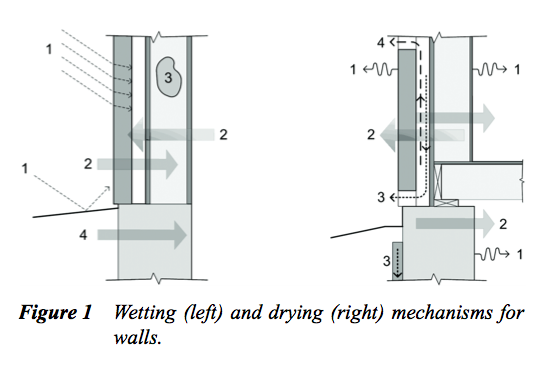
[Excerpted from Finch and Straube, 2007]
“It is well accepted that moisture is one of the primary
causes of premature building enclosure deterioration. Excess
moisture content combined with above-freezing temperatures
for long enough will cause rot, mold growth, corrosion, and
discoloration of many building materials. The four major
moisture sources and transport mechanisms that can damage
a building enclosure are (Figure 1, left side):
- Precipitation, largely driving rain or splash-back at grade
- Water vapor in the air transported by diffusion and/or air
movement through the wall (both to interior and exterior) - Built-in and stored moisture, particularly for concrete or
wood products - Liquid and bound ground water, driven by capillarity and
gravity
At some time during the life of a building, wetting should
be expected at least in some locations. In the case of a bulk
water leak, drainage, if provided, will remove the majority of
the moisture from the wall cavity. However, a significant
amount of water will remain absorbed by materials and
adhered to surfaces. This remaining moisture can be removed
(dried) from the wall by the following mechanism (Figure 1,
right side):
- Evaporation (liquid water transported by capillarity to the
inside or outside surfaces) - Evaporation and vapor transport by diffusion, air leakage,
or both either outward or inward - Drainage of unabsorbed liquid water, driven by gravity
- Ventilation by convection through intentional (or unintentional) vented air cavities behind the cladding
A balance between wetting, drying, and storage is
required to ensure the long-term durability of the building
enclosure.”

